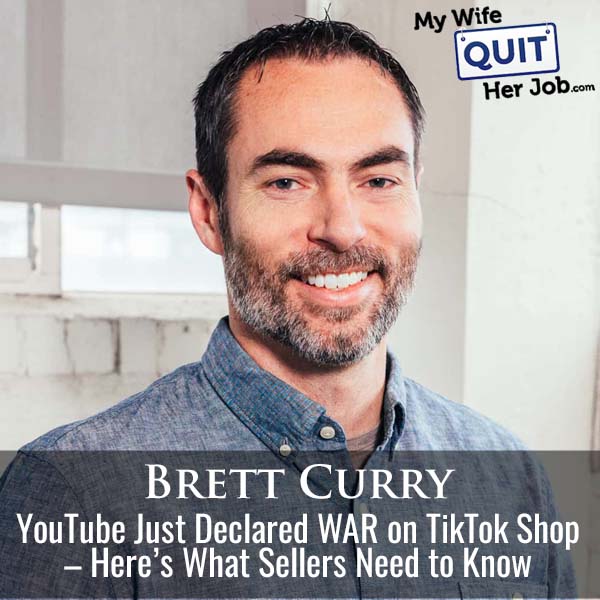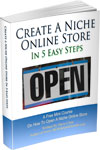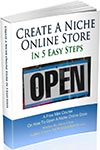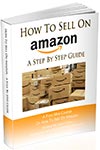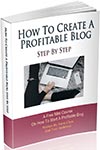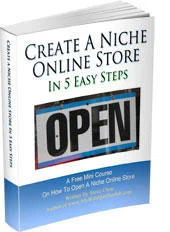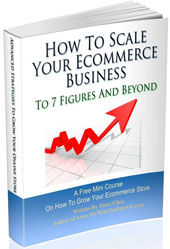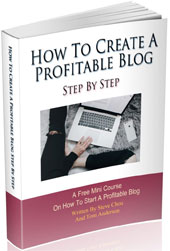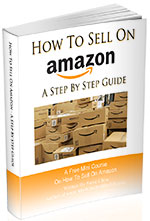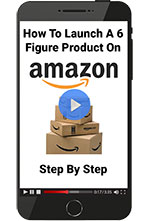Podcast: Download (Duration: 46:21 — 53.3MB)
In this episode, I’m thrilled to have Brett Curry back on the show.
Today, Brett and I discuss how YouTube just entered the ring to compete with TikTok Shop and what that means for sellers trying to stay ahead.
It’s a game-changer, and we’re breaking down what you need to know to keep up.
Get My Free Mini Course On How To Start A Successful Ecommerce Store
If you are interested in starting an ecommerce business, I put together a comprehensive package of resources that will help you launch your own online store from complete scratch. Be sure to grab it before you leave!
What You’ll Learn
- Your social selling options on YouTube
- How does shoppable YouTube compare with TikTok?
- How to get started with YouTube Shopping
Sponsors
SellersSummit.com – The Sellers Summit is the ecommerce conference that I’ve run for the past 8 years. It’s small and intimate and you’ll learn a ton! Click Here To Grab The Recordings.
The Family First Entrepreneur – Purchase my Wall Street Journal Bestselling book and receive $690 in free bonuses! Click here to redeem the bonuses
Transcript
Welcome back to the podcast, the show where I cover all the latest strategies and current events related to e-commerce and online business. In this episode, I have Brett Curry back on the show to discuss YouTube’s answer to TikTok Shop. We dive into YouTube’s latest push into shoppable video content and how it’s reshaping the way creators and brands sell online. But before we begin, I want to let you know that session recordings for Seller Summit 2025 are now available over at sellersummit.com. If you missed the event, you can now get instant access to every keynote, workshop and panel.
00:30
go over to sellersummit.com. Now on to the show.
00:39
Welcome to the My Wife Could Her Job podcast. Today I’m thrilled to have Brett Curry back on the show. Brett is someone who I’ve known for almost a decade now. He recently spoke at my event and I think he’s spoken there, I don’t know, every year for like the past seven years, I want to say. Has it been seven years? He runs OMG Commerce, which is an e-commerce agency that has helped hundreds of companies with their pay-per-click advertising. And we all know that social shopping is all the rage right now.
01:09
And just a month ago, he gave an amazing talk on shoppable YouTube ads, which is Google’s response to TikTok shop. And I did not get a chance to see his talk live, even though it was my own event. But I did catch the recording last night and I had so many questions. So today we’re going to dig deep on how to leverage YouTube for your e-commerce business. And with that, welcome to the show, Brett.
01:33
How you doing Steve? What’s up, man? I am thrilled to be back. I think this may be, is this round four probably for me appearing on your pod, which is great. I love this pod. Love chatting with you and yeah. Hey, solar summit for those that have not made the trip to Fort Lauderdale yet. You got to do it. It’s one of my favorite communities or my favorite events. And yeah, the pack that the talk that I gave this time was packed and was back. Yeah. People want to know about YouTube, right? People want to diversify and understand what’s cooking there. And so
02:02
Yeah, we got YouTube ads and we got YouTube organic and we got YouTube affiliate, which is kind of their answer to TikTok shops. so lots of fun stuff we could dive into. So what’s up with OMG. So are more and more clients asking for social promotion now and TikTok YouTube help? Yeah, it’s really interesting. So, uh, we don’t do TikTok shops directly. We do pull in a resource. If a client really wants that and they don’t have a solution for it. Uh, people are talking about TikTok shops.
02:29
regularly, although it is a bit split. I’m not sure what you’re hearing, Steve, but, like we, uh, it kind of runs the gamut. So a good friend of mine, actually, you know him too. I didn’t get approval to mention this. I won’t say his name, but he’s literally five X his business was not a bad business, but literally five X growth on Tik TOK shops. Just talk to, uh, um, another brand that everyone would know here. They’re in the food and Bev space and they’re like, yeah, tried to talk shops, did nothing like we’re, we’re abandoning it. We’re doing other things. Right. So.
02:58
It does seem to be hit or miss. does seem to apply to certain categories and maybe not as well to others. Uh, but people are still interested. but yeah, the, the interest in YouTube over the last quarter, uh, has really ticked up. And I think there’s a few reasons for that. One, there’s just a constant drive to diversify. So still most DTC brands, the majority of their ad spend is on meta and that’s fine. Uh, probably rightfully so for most brands.
03:26
But that’s an uncomfortable place to be in, right? If I’m spending 70 % of my ad budget on Meta, I feel like Zuck has got a little bit too much control over my brand, and so I’m looking to diversify, so that’s a piece of it. But then there’s also, did you see the House Analytics incrementality study done on YouTube? And it’s H-A-U-S, but that the one you referenced in your talk? It’s the one I referenced in the talk, yeah. Super interesting. So my friend Andrew Ferris, awesome podcast. He interviewed Olivia Corey from House Analytics, but basically,
03:56
You know, what they did is they studied like 190, they did 190 incrementality studies involving YouTube, 74 brands. So these are big brands like AG1 and Ridge and stuff like that. And they found that, that YouTube is wildly more incremental, wildly more impactful. You’re have to define all these terms by the way. will. Yes. Okay. Yes. Yeah. So it’s wildly more impactful in terms of real results than what you see in platform. And I think a lot of us are used to platforms.
04:26
over-exaggerating, right? Or like platforms taking credit for everything. For a few reasons, and I can unpack them here as we go, YouTube is the opposite. YouTube is going to under count, under report. So it’s going to look bad in platform, but the real results are quite positive. And so we can unpack that, but that’s just kind of ton of coverage in the space. And so a lot of people are like, Hey, I need to give YouTube another look. And so, so we feel that a lot of conversations because of that. Let’s take a step back.
04:52
Just in case the listeners have no idea anything about YouTube, but what are shoppable YouTube ads? Can you just define that first? Yeah, yeah. So there’s a few, there’s a few ways to look at this. So, um, shoppable YouTube ads, um, those can just be like the pre-roll ads. So I’m on YouTube. I’m about to watch my Mr. Beast video or a, you know, cooking video or whatever. There’s a pre-roll video that pops up. Usually they’re skippable. So I can hit skip after five seconds.
05:18
And they either have just a call to action button around it, or it could have your products listed right beside that video. So that would be a true shoppable ad where it’s like, your product feed for relevant products that you talk about in that video, they’re right there by the video on YouTube. So can click and buy there. There’s certain cases we use those in certain cases we don’t. And then, and then you’ve got the opportunities to take creators content. So, so people that.
05:47
have a following on YouTube, they may be talked about your product and you can turn that into an ad as well. And so that there’s opportunities there. But YouTube is, it’s an interesting beast, right? There’s so many different platforms. Like it’s wildly popular on connected TVs now. It’s most streamed connected TV channel. It’s, you YouTube shorts is growing, things like that. Yeah. I was just looking at my channel statistics for YouTube.
06:16
And it was something crazy, like almost 40 % watch my videos on a TV and not on a phone. Yeah. I’m sure that I’m sure that surprised you, right? Like really people are watching e-commerce news and events and stuff on, on TV, but exactly the answer is they are. just shows like TV is hurting. It is. Yeah. Yeah. Well, I mean, so get a little of this. YouTube has been, uh, and this is not just YouTube TV. YouTube TV is thrown into this. So like we, use YouTube TV.
06:46
As a family so that that’s our cable subscription. So I watch ESPN and all the sports program and I watched that through YouTube TV, but, uh, this is way more than that. So this is, know, the good old fashioned YouTube app, but on connected TVs, it’s bigger than Netflix. It’s way big. it’s bigger than Netflix. Netflix is number two, but YouTube is bigger than Hulu. It’s bigger than Disney plus it’s bigger than Peacock and it’s bigger than one other, a prime video, all of those combined.
07:14
Meaning more people stream YouTube on their connected TV than all those other platforms combined. Not more than Netflix. Netflix is number two. But yeah, people are just consuming YouTube on connected TVs. And it’s a great experience, right? Like when I let my kids watch TV, they’re oftentimes watching YouTube and consuming it that way. So it’s a great user experience, but it does feed back to the tracking issue that we had before. that’s what I was getting watching on TV, there’s no clicks.
07:43
Right. can, you can send to phone, there’s QR codes and stuff like that, but most people don’t do that. Right. You’re, you’re watching, you’re watching TV. And so, um, there are essentially no clicks from there, but those ads can be very, very impactful. So in your talk, you mentioned like if the YouTube dashboard for your ads says a one X return on ad spend, it’s really equivalent to three and a half or something crazy like that. Yeah.
08:07
And then so one of the tenets of your talk was stop paying attention to ROAS and start paying more attention to IROAS, which I wanted you to define real quick before we go into depth. So the, the I and IROAS, it’s not, it’s not an Apple product, right? That’s kind of what it sounds like, but it’s, but it’s a, it’s incremental ROAS, meaning it’s the cost for sales you wouldn’t have gotten anyway. And that’s, that’s the essence of incrementality. Right. And I think a good example to use here.
08:37
Let’s take branded search and we don’t want to make this podcast about branded search. I’ve definitely got a point of view there. I think you should do it, but you should, you know, temperate. Don’t want to spend too much, but it’s probably one of those things where if you turned off branded search completely, you might not feel the impact, at least not right away on your business. Right. So that that’s not incremental, meaning you turn it on, you turn it off. Yeah. Not really getting any additional sales. However, for a lot of brands, if you’re spending 70 % of your budget on meta,
09:06
and you shut Meta off, I promise you, you’re going to see a decline in sales and not just a decline in Meta sales, but you’ll see a decline on Amazon and other places and stuff like that. Yep. So that’s, that’s highly incremental, meaning, uh, you, you got those sales because of the advertising and you wouldn’t have gotten them otherwise. So that that’s true incrementality. And so, uh, what Google does now and Meta does this and stuff too, is that they’ll, they’ll do incrementality studies on your behalf where they’ll look at,
09:36
Hey, these are users that saw an ad. These are users that didn’t see an ad. What was the purchase behavior? How different was it? And so that’s going to give you kind of this IROAS number to say, what’s really going on with my advertising? Is this really working or is it not? Do they do that for everyone or just the big guys? So it’s becoming more and more accessible. And we actually just did a training with our Google team earlier this week.
10:01
where there’s, three types of studies that we try to run on a continual basis for our clients. Uh, one is called brand lift. And you’ve probably seen this, Steve, if you’re on YouTube, sometimes that pre-roll ad that you get served is a survey. Like, Hey, have you seen an ad for Geico and Allstate and, uh, you know, progressive this, this month or whatever. And so you click yes or no or whatever. Um, so that that’s part of brand lift. Uh, so, so Google is.
10:29
conducting those surveys on behalf of their advertisers and then feeding that information back to advertisers. So what you can do with brand lift is you can see like, Hey, are my ads causing an increase in awareness? Are they causing an increase in purchase consideration? But it’s all survey based. think those are mildly beneficial. I think you’re spending a lot of money. They can be. And if you’re definitely, if you’re progressive or if you’re all state or something like that, you probably want that data.
10:54
I think for a lot of our clients, for a lot of DTC brands, you eight, nine figure brands, it’s, it’s somewhat helpful. Um, so that, that’s one thing that we do run just, just in case there are some good insights there. Uh, the next thing is search lift. I love this one. So this is where Google looks at, Hey, people that saw your ad, people that didn’t see your ad, how did they differ in their search behavior? So basically what this is trying to understand is if someone saw your YouTube ad,
11:21
Are they more likely to search for your brand and specifically how much of a lift did that create in searches? I love this metric because I think this is what YouTube should do, right? If I’m on my TV, I’m watching the latest Steve Chu video. got popcorn and a LaCroix whatever I’m, you know, whatever I’m consuming and I see this ad. I’m like, Oh, that’s interesting, but I can’t miss Steve Chu. Like I got to stick around and watch this. So, but afterwards I’m to go search right afterwards. I’m going to go search for whatever ad I saw and that’s how I’m going to do it. And so.
11:50
That search lift super, super important. So we run those continuously. And then the third one, and this is newer. This is like the IRO ads, what I was talking about. It’s called conversion lift. And basically it’s similar to search lift. It’s like, Hey, here’s a group of users that didn’t see your ad. Here’s a group of users that did see your ad. What was the difference in purchase? they split test out. Does that happen automatically when you run YouTube ads? It does not happen automatically, but you can set these up to be running.
12:19
continuously. And so then you can constantly be measuring it. So then it’s like, okay, I can see click data. I can see conversion data. I can see view data. All that is automatically there. But then these are additional things to layer in because we’ve seen this a lot, like, you know, big, advertisers, Arctic, uh, they’re more than coolers. We did a big push for them last year for coolers, their Yeti competitor. And our, our whole goal was can we drive sales to Walmart? And it was a, it was a considerable lift. It was like range from
12:47
15 to 25 % lift in Walmart sales because of this ad campaign. We won an agency excellence award for it. But those were like, you didn’t see those conversions in YouTube, right? Cause those conversions were happening on Walmart, but we were able to kind of see search lift and brand lift and some of these things that helped, you know, inform, are we on the right track as we’re going here?
13:11
I just wanted to take a moment to tell you about a free resource that I offer on my website that you may not be aware of. If you are interested in starting your own online store, I put together a comprehensive six day mini course on how to get started in ecommerce that you should all check out. It contains both video and text based tutorials that go over the entire process of finding products to sell all the way to getting your first sales online. Now this course is free and can be attained at mywifequitterjob.com slash free.
13:41
just sign up right there on the front page via email and I’ll send you the course right away. Once again, that’s mywifequitterjob.com slash free. Now back to the show.
13:52
So here’s my problem. Like I’ve been spoiled with ads, right? Where you get a click and it leads to a conversion and you can tie it. And if you use tools, you can see the whole click path, right? My problem with YouTube ads is it’s kind of like TV, right? In the old days, Where you run the ad and you might see a lift, but it’s not really easily measurable. Right? So as a small guy, like a little guy, and I want to run these YouTube ads,
14:22
how am I gonna prove to myself that I’m not just flushing money down the drain? Yeah, yeah. It’s a great call out. And so I think that there’s a few things to keep in mind here. That analogy is really sound. Now I think YouTube isn’t just like TV, but I think it’s like this generation’s TV only, way better in a lot of ways. Yeah. But you got YouTube shorts, which is a little more social and things like that. But.
14:46
But yeah, back in the day, if I was running a TV ad, I got no click data. I got nothing, right? I could just see did the cash register ring a little bit more? Did I get more cash coming in? But we’ve all been spoiled, right? Cause we’re running sponsored product ads on Amazon, running Google shopping ads on Google. We can see click keyword, purchase. can see all that stuff, right? And I do think all of those things are the best place to start, but here’s how I would, I would look at YouTube if, if I was smaller and even going back to like that house analytics study.
15:17
That was AG one and Ridge and you know, eight and nine figure DTC brands. So what they do isn’t necessarily what the rest of us would do right out of the gate. So I’ll give you an example. Um, got a client, they they’re in the pickleball space. So pickleball apparel, pickleball paddles, awesome, awesome brand. So they’re like, Hey, we’ve got some pretty cool YouTube content. How do we get the most out of that? How can we lean in and start getting traffic? So here’s what we recommended to them. This is one of those categories.
15:47
Where if someone is into pickleball, they are really into pickleball, right? So it’s almost like golfing or, or, you know, camping and outdoors and fishing or about a four by four truck a couple of years ago, I got really into it for a little bit. Um, I’m into Blackstone, you know, griddle cooking on a griddle now. Someone’s watching Blackstone videos. so pickleball is like that, right? Like you, when you are interested in pickleball, you start watching content for fun about pickleball.
16:11
So here’s what we did. We’re like, Hey, let’s, let’s get some of your review videos, your, your reviews about your paddles and their paddles are unique and they’re, they’re awesome. And like the founder of the brand was a championship pickleball player or whatever. so like, Hey, we’re, we’re, we’re going to run some view based campaigns, meaning we’re running these campaigns to get views, to get engagements, just to show up, you know, in front of people. We’re not going to see probably any conversions really not, not directly attributable conversions, but that’s okay. We’re not going to spend a lot of money on it. But then what we did is we Hey, let’s target.
16:41
these pickleball channels. So these are our favorite pickleball tutorial channels, people learning how to improve their serve or improve, you know, whatever their doubles game or that type of thing. Or there’s also some channels where these are all pickleball paddle reviews, right? So someone is watching a review on pickleball paddles and that’s something that’s really been growing over time where, people will use YouTube for years, like for product recommendations and product reviews, but we’re seeing that trend line increase.
17:10
Where people are looking at, this product versus that product on YouTube or this product review, this product demonstration, they’re looking for that on, on YouTube. And then in fact, saw a stat recently, it was kind of interesting that, that 80 % of, uh, users on the internet say they trust YouTube creators more than other influencers or more than other creators. And so I that was, thought that was kind of interesting, but people go to YouTube to look for these recommendations. So we’re doing for the pickleball companies were saying, Hey, let’s just run your.
17:38
pickleball paddle review video and some of these educational videos on your paddles, let’s just target all these channels. We won’t spend a lot of money. You know, maybe it’s, I can’t remember exactly what we recommended for them, but maybe it’s 20 bucks a day. Maybe it’s 50 bucks a maybe it’s a hundred bucks a day. We’re just getting views. Just getting views. Now you’re not going to get conversions there directly, but over time you can start to see, are more people searching for my brand on Amazon or more people searching for my brand on Google? Am I seeing a lift in?
18:05
unattributed sales, right? Where maybe I’m getting like a lift in direct sales, you know, through Google Analytics for things like that. So you have to just start do a little more sleuthing or a little more looking for, okay, where could these sales be showing up? So that’s the that’s the way to get started. Now, if you want to go hard on like, conversion focus campaigns, I’m bidding to get customers and acceptable CPA or acceptable CAC or whatever, then you got to kind of shift gears into a conversion focus campaigns and those
18:35
They don’t technically have minimums, but like there’s some kind of rules of thumb you need to use to get, to get the algorithm enough conversions where it actually is going to work. Um, and so that does often take minimums. Like you probably want to be in the three to $500 a day, maybe a thousand a day is even better. Like to get, get those campaigns going. Can you set some expectations with the first method that you described? Like how much time should you give it minimum? Yeah. Yeah. So there’s a couple of things you can look for here. I would, I would totally look at that as a long-term play. So set a budget where it’s like.
19:04
I could spend this for three months and if nothing happens, I won’t be excited, but it won’t kill me. But what I would look at immediately then, so start running those campaigns, look at what is my view rate. So with all of these ads, someone can choose to skip if they want to, The pre-roll ad pops up, you’re like, curse you ad, I want to move on. So you can see what the skip rate is, what the view rate is. Generally speaking, I like to see a view rate that’s north of 20%.
19:32
If that can be north of 40 % even better, if it’s on a connected TV, it probably does need to be like 50 % or higher to show like, Hey, this is good content. People like it and I’m reaching the right, the right audience. So I would look at view metrics right away. You can look at things like, um, uh, views that happen after they watch that. So if you’ve got a channel, like I know you’ve got a channel, this, this pickleball company has got a channel. So did somebody see the ad and then did they consume more of my content?
20:00
That’s a good signal that hey, okay, they’re kind of my content and checking it out. And then what I would look for is, okay, am I seeing a lift in branded search? Am I seeing a lift in direct traffic and things like that? But I would definitely run it for several weeks, but just know you can get that view data and that engagement data really quickly to show, I reaching the right person and is my creative striking a chord? And it sounds like branded search is a really good indicator, right?
20:29
It is, it is. Yeah, because I mean that that’s generally the next step, right? Occasionally someone’s going to click. You’ll get click data in these campaigns too. So even if it is a view based campaign, you’ll see click data. It’s just not that many people click, right? It’s like half the click through rate of meta. So it’s not that it’s not that much, but you’ll see it. But then it’s like, yeah, are people searching for me? But I would also, I would look, you if you’re selling on Amazon and you’re selling on your own.com, look at branded search in both places. We ran this for, you know, we ran YouTube at the
20:57
got to almost a million a month in spend for big haircare brand, their Amazon just took off like a rocket. we determined over time they had a data scientist team. pretty, pretty advanced, pretty sophisticated, but they determined for every one sale we were getting D to C from YouTube, they were getting two on, on Amazon, uh, just kind of based on the way they backed into the numbers. So, uh, you do have to look at, at both places, both
21:22
and on Amazon if you’re selling in both places. Yeah, I think the numbers for TikTok Shop are similar. Yeah, I bet they are. and maybe like 30 % on your DTC store. Yeah, yeah, so it’d be almost exactly the same. Yeah. Well, I want to switch gears a little bit and just kind of talk about YouTube’s answer to TikTok Shop. And it’s pretty new. It is. Not a lot of people know about it. So give us a scoop, Brett.
21:49
Yeah. So one, I’m really excited about this. I don’t know that this current iteration is going to be the thing or the answer, but I am optimistic that YouTube is going to be able to figure this out. And honestly, if they don’t figure it out, that’s on them, right? YouTube, YouTube’s got the viewers. YouTube has the creators, you YouTube has the format. Like this should work if it doesn’t, that’s just cause YouTube drops the ball. Right. So I do want to make a couple of comparisons here where, um, you know,
22:19
TikTok I think has the ability to go viral quickly, right? Like the right creator, the right content, it can go from zero to off the charts viral. YouTube doesn’t really do that, right? It’s, know, yes, there’s viral content, but a lot of times the content gets better over time, right? You post a video that’s a review on, you know, the latest Toyota Tundra or you post a video that’s the, know, this new Blackstone accessory or whatever, it’s probably gonna grow over time and maybe.
22:46
two years from now, it’s getting more views than it gets right now. Whereas, know, Tik Tok, it’s dead and you know, a week or whatever. So it’s just, it’s just different. But the way this is working now is Google has created a portal where you can connect your brand with creators on YouTube. And this is all kind of done through merchant center now. So if you’re running Google shopping, you’re running performance max, you’ve got a merchant center account.
23:13
That’s where your, your, all your product data, your, your, this where your product feed lives is inside a merchant center. need to have a feed in order for this to work, right? You do need to have a feed in order for this to work. You do. Yeah. And so, so then the way this works is basically you get signed up for the program. It’s, it’s an open beta now, so anybody can, can get involved. Um, you set a commission. So you’re like, Hey, I’m willing to pay 15, 20, 30, 50, whatever the percentage you’re willing to pay to a creator if they sell my product. And then creators can, can see that.
23:42
You know, they sign up for the program, they select your brand, they start tagging your products in their videos. Let’s say that I’m doing a makeup tutorial and, uh, you know, boom, I, Cindy Joe’s or boom beauty. mean, uh, as a fire company, we’re like, Hey, I love the moisturizer. I’m a type of moisturizer. Right. And so you tag that. And then in the video, we’re talking about moisturizers that shoppable clickable, uh, product listing pops up.
24:08
they’re right adjacent to the video. kind of below it, if it’s on mobile, beside it, if it’s on desktop, type of thing. And so then if someone’s watching that organic piece of content and they see the tag for that boom product, they click on it, they buy, now that affiliate gets a commission. And so it’s pretty slick. There’s still some bugs to be ironed out. Like right now you can find creators that you want to reach out to, but you can’t reach out to them in the platform, right? You got to like…
24:36
You can find them inside of a YouTube affiliate, but then you just got to manually go reach out and find them. People can find you and that’s what we’ve seen. But I’ll give you some numbers here that kind of paint, think the potential here. So we have a client in the sleep space, a really cool brand, fun brand. So we set them up here. We didn’t do a lot to promote it. We’re like, Hey, let’s just see. They didn’t do a lot to promote it. Well, a handful of creators like, we love this product. We’re going to tag it and start trying to sell it. And so.
25:04
I think this was over like the last six months or so they’ve gotten 20 million organic views. Uh, they’ve sold, I don’t know, 20, some thousand dollars worth of products paid out like four to, I don’t remember maybe $6,000 in commissions. Um, I think the CPM worked out to be like 15 cents or something crazy like that, right? Where like, you know, a good, a good CPM on Google or on YouTube ads is like from
25:29
You know, $18 on down and a medic can be kind of all over the board, but yeah, it was like 13 cents cost per per thousand. Right. And so, yeah, I think there’s, there’s real potential here. As long as Google can make this easier for creators to find products for brands to connect with creators. I kind of think they need to solve that communication piece eventually. That’s gonna, that’s going to be really helpful. Uh, but that’s, that’s basically it. It’s Hey, creators can tag your products in.
25:58
their organic videos, they’re in a commission, you get, you know, the exposure from those organic videos. And so it’s pretty powerful. Then similar to TikTok shops over time, you can say, oh, wow, these three or four, 10 creators, like their videos really took off. So I’m gonna take the clip of them talking about my product. I’m gonna turn that into an ad. And so that’s called… Walk me through the process because I’m pretty familiar with the TikTok shop process where you…
26:27
have to get a certain number of sales and then you can message, you know, 7,000 creators a week and whatnot. It’s all built in. Is the affiliate program at least built into YouTube directly? So you don’t have, does YouTube handle the money? Yeah. So YouTube will handle the commissions. Yep. They can handle it. you or the communication is up to you, but basically this is all set up in, Google merchant center. And so there’s, there’s a couple of caveats here. Uh, one in order to participate, you have to either use the Google YouTube app.
26:56
by Shopify, so it’s the Shopify app. A lot of brands are using that anyway. If you’re not using that though, there is good news in, let’s say you’re using like Data Feedwatch or Channable or Feedonomics or something like that. You can keep using that solution for shopping and PMAX and stuff. You’ll need to add though that Google and YouTube app for Shopify for the YouTube affiliate. So you’ve got to have that so that’s a must or.
27:23
You gotta be using a CJ, which used to be Commission Junction. Yeah. Impact. And there’s one, there’s one other, I’ll look it up here in a minute. That’s okay, yeah. While you’re talking. But there’s like four options. So you gotta have that set up. If you have that set up then, then you know, YouTube can handle the commissions and stuff like that. I see. So YouTube, if you’re using like CJ or whatever, you’re using CJ’s affiliate, or YouTube is using CJ’s affiliate link. Yeah. And it’s all tracked. You connect the two.
27:51
So whichever those you’re using, you’re connecting that to Merchant Center and it’s a YouTube affiliate. And basically then in your Merchant Center where you see like promotions and products and stuff, there’s going to be a section that’s YouTube affiliate and you’ll click in that and then you’ll see all your data. is not collecting the money in this case. Correct. Oh, okay. So the reason why I’m mentioning all that is that means the merchant is responsible for paying the commission. Yeah. So if they choose not to, I mean, in theory they could screw over their
28:21
affiliates, which has happened in the past. It’s happened to me a bunch of times, actually. Interesting. Interesting. Yeah. So I’m not sure all the remedies that Google has in place, you know, to protect creators and brands and stuff like that. But I do think there’s going to be a solution where people can just check out. know, I mean, there’s I there’s some options that the Google’s played with in the past. I it’s great for brands, right? The checkout happens on their site, right? And they all information. You own the customer at that point. All of that. Fantastic. OK, it’s great for merchants. OK, I like it.
28:50
Okay. Walk me through the process of outreach. Like you worked with this brand, right? You have to get people to promote your stuff. do, you do. there’s a, one of the easiest things to do is you can, there’s like this, um, uh, this way to promote your offer to creators. And this is something you sign up for inside of merchant center. And so basically it’s like, say, Hey, this is our normal commission rate. We’re doing a deal where we’re doubling the commission or whatever for this period of time. Here’s why here’s some messaging, stuff like that. It’s basically a form you fill out. That’s like a promotion.
29:19
Google then will send that to creators and for them to say, oh, cool, I like this. I’m going take advantage of this. So that’s probably the clearest, easiest thing to do. Also, if you have stuff built and you’ve got a bit of a brand anyway, creators will find you, right? I obviously wouldn’t lean into that. It’s like your, the field of dreams strategy, right? If we build it, they’ll come like that. lean on that. But that does happen if your brand has got some traction.
29:47
But then the other piece is like, it’s just super duper manual right now. So what you can do, and this is helpful-ish, you can start searching within the YouTube affiliate portal inside of Merchant Center and say, okay, I want like plant-based diets or I want, you know, black stone griddle cooking, or I want fly fish, whatever the case is. Then it’s going to populate here the top creators.
30:11
You can start looking at filters for like, Hey, I only want people that have gotten, you know, 50,000 views in the last 30 days, or I want people with a certain subscriber count. And so you can start to filter those. You can then build a list and you can save that list, but then it’s, up to you to just go knocking on those doors, right? you can reach out through like their YouTube channel and stuff, but you can build, you can build the list and you get the stats and you get all the information. Um, you can also then decide, okay. Uh, it’s like, this is my.
30:39
top tier of affiliates I wanna go after or creators I wanna go after. So I’m gonna build this list and all of these people, they get a 30 % commission, right? Everybody else gets a 15 % commission or whatever. And so then you can reach out and tell them like, hey, I really wanna work with you. I love your content. I’m doubling your commission, whatever the case is. And so then that makes that outreach a little bit easier. So yeah, it’s pretty manual at this point, but you at least have a few options that makes it a little bit easier. So right now it’s basically the old influencer model.
31:09
with the exception that they can easily grab your products and tag you in there. That’s the new step. Super easy. It’s like, yes, great. I love this makeup brush or this whatever, this Blackstone spatula. So I’m just going to tag it in my video and boom, now I’m done. Now Google tracks it. And only approved affiliate platforms are allowed. Yep. Yep, exactly. So you can’t It’s really just those that I mentioned. Yep.
31:35
Oh, just as, so you can’t take like a refversion or something like that, which you already have on your Shopify store, for example. No, no, you can’t use it. Okay. You can’t use that. So yeah, it’s gotta be that. It’s gotta be that YouTube app. Um, so it’s gotta be the Shopify YouTube Google act, uh, app. can be impact Rakuten or CJ. are the only options. Like those are like the biggest ones actually. Biggest ones. Yeah. Okay. I get it. Yeah. This is a lot different than Tik TOP, which manages everything. Right.
32:04
And you would think that with YouTube’s resources, they could easily replicate this. would think so. And I think they’re going to get there. We’re connected to a couple of the global product managers that are running this. And so I’m talking to them all the time. I they can’t be like super open about what’s, what’s on the roadmap, but I think they’ve got to get there just because then they’ll never be able to compete. Right. The beauty of TikTok shops is you can do it all there right now. can’t inside of YouTube, but I still think it’s worth.
32:31
test it out because they’ve got all the ingredients to make it work. Yeah, I like the idea, but just think about it from a creator perspective. Now I need to go sign up for CJ or Impact, which I guess isn’t a big deal. I already have accounts of both of those. But the fact that each one could potentially have a different one, Yeah. like the idea. Is this mainly for long form or does it apply to short form as well? In terms of the creator content, longer, form content?
32:58
It can be either. Yeah. So that this can apply to, to shorts. They can apply it to long form. You know, it does seem like a lot of the videos that get traction from creators are, are longer form, know, five minutes, 20 minutes, things like that, somewhere in that range, but it does depend. And this can work for shorts. Okay. So let’s tie it back to our original conversation now with IROAs. All Yeah. Most of these people are watching stuff on their TV, tick tock. Everyone’s on their phone, right? Yep. So
33:24
If this shows up on the TV and there’s products there, there’s no click, that means the affiliates don’t get paid out, right? And then the brand equity is, for the seller, it’s great, I think. You get the brand equity no matter what. It’s a great question. mean, so I think one of the things that Google is trying to solve, and they’re talking about this, they’re talking about this a little bit at Google Marketing Live recently.
33:49
is depending on the kind of remote you have for your connected TV, you can navigate to click on that or whatever. I don’t know, that seems a little bit cumbersome. I don’t tend to do that with my remote. I don’t think a lot of people do. You’ve also got the QR code that people can scan and stuff. But yeah, it does create a bit of an issue, right? So yeah, is Google gonna be able to attribute that back to the creator?
34:14
That does that does create some challenges seems like Google needs to use Google pay for all this stuff and not take to do the transaction on the On the Shopify store. Yeah, potentially and then maybe maybe that’s quickly on the horizon I’m not I’m not sure but that that in a lot of ways that does make sense
34:30
Yeah. Okay. All right. So it seems at least to me, and I know you’ve gotten results with your clients. It seems to me it’s not quite up to par with TikTok shop. Just not for sure. Not no, it’s, it’s in its infancy. Um, so this is more like, Hey, do you want to be an early adopter? Right. Do you believe in YouTube? Does your product really fit with like YouTube creators? I think a lot of products do. think there’s creators for almost any, any niche, but, but yeah, it’s not built out in the same way where like,
34:56
you’re not gonna five extra business with YouTube affiliate like you might with TikTok shops right now. But getting in early may cause you to be ahead of your competitor. Yeah, okay. So it seems like what we talked about in the beginning with YouTube ads is completely different than what we just talked about. It is. Right? It is, yeah. If you already have an influencer marketing strategy, this is just like one extra piece to it where you’re saying, hey, now you can tag the product super easy and this is how you do it.
35:26
Yep. Whereas before you’d have to put the link in the description and, and whatnot. Right? Right. Right. Yeah. Yeah. So some other way. like, you know, uh, know Sean from the Ridge, brilliant guy, you know, one of the ways they really grew the Ridge in the beginning was they reached out to a ton of YouTube influencers, like Fortnite, uh, creators and, know, just men’s fashion and whatnot. And they’re like, Hey, just, you know, talk about, a live read of Ridge in the middle of the video. We’ll pay, we’ll pay you for.
35:54
pay commissions, then yeah, then you’ve got to like give them their own link. They’ve got to, know, reference that in the video. Sometimes you’d like, we’ll just pay you for views type of thing. uh, but that’s all, that’s all very, very manual. This at least is easier in that tag a product, track it, you know, it’s pretty, straightforward. walk me through the negotiation then. So can you pay a creator less to make the video now and include the commission since it’s in theory, more commissionable. Does it change the negotiation?
36:23
Yeah. So potentially now, uh, I haven’t talked to Sean about this specifically, I hear using YouTube affiliate and you’re doing your old outreach. I’m not really sure what he’s doing, but, for the brands we’ve helped so far, they’ve kind of created treated. This is just separate, like, Hey, just tag the product. We’ll pay the commission end of story type of thing. Okay. So I know, I know other people just talking to another agency owner recently and they’re, they’re looking at, let’s reach out to a creator. We’ll pay them for the first 30 days of the views. We’ll pay them on a CPM basis.
36:52
So I think you got stuff like that. You could layer that. You could say, I’ll pay you a CPM and I’ll pay you the commission on the product. So I mean, think there’s a variety of ways you can go. But most of the people that we see testing this right now, they’re just saying, hey, tag the product, we’ll pay a commission and it’s a win-win at that point. Got it, got it. I guess the hard part is always to get them to make the video, right? Yeah. They have to feel incentivized that they’d be able to do this.
37:20
And that’s where I think, um, cause we had a conversation about this just recently. Someone was like, well, I want to pay like a 10 % commission. I’m like, wait a minute. What do you, what’s, what’s like your customer acquisition costs? Like what are you paying? You know, meta or Google or like a, you know, two, 2.5 ROAS. like, so you’re giving up almost half the sale to meta, but you only want to pay 10 % to the, they’re not going they’re not going to do it. Like why, why want to pay them the same or, know, anyway, so, so you got to think about it. It’s psychological. It’s totally psychological.
37:49
Well, that’s different. Well, I mean, okay. But, uh, and so I’m not saying you have to give away half, like incentivizing, like the, the, some, good affiliates are good and they’re, they’re going to go after they’re going to lean into the products that they pay them. And so, um, yeah, that’s how it’s going to ask you actually too, cause at least on Tik TOK and whatnot commissions are typically, you know, 15 to 20, but you’re right. Like if you’re, if you’re paying 50 % on meta, like,
38:18
For some reason there’s this psychological barrier. There is, there is physical products where people don’t want to go beyond 20. Yeah. Right. And that’s, that’s a five, that’s a five row as you’re paying 20 % five row as you’re probably not getting that anywhere. I, Hey, listen, I’m a huge fan of testing. Like if you start running a 20 % commission, you start getting results or 10%. Great. But I would just challenge that thinking of, what is my acceptable cost per acquisition? And I’ll pay close to that.
38:45
to an affiliate, to a creator, right? Because it’s the same. All right, so we actually talked a lot in a lot of broad categories in this talk. So give me your perfect customer or store that would want to try YouTube ads. Like how much are they making? How much are they willing to earn? It’s a great call out. I think
39:08
The easy answer is like if I was a, or the broad answer is if I owned a brand of my own, I would almost certainly try YouTube to some degree. So I might do that first strategy. talked about like the pickleball company where it’s like, I’m spending 20 bucks a day, 30 bucks a day targeting these types of channels and stuff, just because I think it’s going to have a little bit of an impact. Now that’s not like the best client for us necessarily. And so let me kind of differentiate that and let me talk about.
39:36
who do I think can really scale on YouTube? Who are the brands like in that house analytics study that are, oh, and also those brands were spending about 30 % of their meta budget on YouTube. So they’re spending a million a month on meta, they were spending 300,000 a month on YouTube or more. So that was just kind of as a comparison or as a point of reference. But basically what I’m looking for there is one, I do wanna be comfortable with knowing I’m gonna have to kind of triangulate.
40:05
the performance of YouTube, it’s not gonna be quite as clear or cut and dry as it is inside of Meta. So you gotta be comfortable with that. Also, I’m looking for either something that’s high LTV, meaning it’s a subscription-based product or multiple purchases, or I know I’ve got a doubt then how much I’m gonna earn from a customer, like in the first 60, 90, 180, that type of thing. So what’s that LTV? Or it needs to be a higher ticket item product. So like higher consideration set and things like that.
40:35
If this is a commodity product, a lower price product, I may not lean into YouTube unless there’s a ton of volume. Some exceptions would be like native. ran natives YouTube for six years. They grew tremendously with it and stick a deodorant, it’s 12 bucks or whatever. It’s a consumable though. It’s a consumable and you know, like, Hey, that’s a high LTV. So I get someone trying native. They love it. They’re going to stick forever. we, you we ran their direct response, uh, YouTube. ran YouTube to drive retail sales.
41:03
in, you know, Target Walmart, CVS, things like that. But generally, yeah, I want someone that’s got a higher LTV or a higher AOV. And so generally, like, if I am looking at a direct conversion campaign in YouTube, meaning I’m bidding on conversions, I’m training the algorithm on conversions, it’s pretty rare that you see a cost per conversion under 50 bucks, right? You just rarely see that. Now, generally, there’s gonna be other conversions happening that you can’t track, so it’s probably lower than that.
41:32
But just know in platform, that’s probably what you’re to see, but it may be pushing like 80 or a hundred. So you’ve got it. You got to kind of understand that that’s what it’s going to look like. And so am I, am I comfortable with that? And, so, so generally that’s what we’re looking for. And then I want, I want something that’s, it’s also lends itself well to visual storytelling. Um, and this can be about anything, right? We, we partner with the folks at Raindrop Raindrop creative. they did a lot of work with native and we were working there.
41:59
Uh, but they’ve got like laundry sauce, which is laundry detergent, right? They’ve got a Dr. Squatch, which soap, uh, shady rays, which is sunglasses. So it can be about anything, but can you lean into some good visual storytelling? That’s important too. I did kind of wrap that thought. I like, Hey, basically I talked about LTV AOV, you know, 50 to a hundred dollars CPAs, which are going to see in platform. And then said, it’s got to lend itself the price of lending itself well to visual storytelling. So I kind of wrapped with that. So.
42:28
So let’s wrap this up then. It seems like a few things are a no-brainer, right? It seems like you should hook up a merchant center account, no matter what brand you are, and just get your products, and at least you have that worst case scenario, you just start making your own products and your own videos. Yep. Right. And then if you do do influencer marketing or outreach,
42:52
you should just consider telling them, like if they’re YouTubers, hey, now you can easily tag products where this one’s available. Exactly. So you’re doing TikTok shops, you’re doing other affiliate outreach. Yeah, just share with those affiliates, hey, we’re on YouTube affiliate as well. Here’s how you tag it. And we’d love to pay a commission on YouTube as well. Yeah. And then for the other ads, it sounds like you said you should just dabble with just getting your brand out there in the beginning. And then if you’re seeing traction, maybe it might make sense to do a conversion. Yeah, I think so.
43:20
The nice thing is if you start kind of small and you’re just comfortable with, with view-based metrics and not seeing direct conversions, that’s at least going to show you like what hooks resonate, what are people engaging with? You will see some clicks. I don’t want to say there’s no clicks. And you can also see, okay, I ran these five videos. These two had the best view rate and the best click through rate. So, okay. I could probably do something with these. Right. And then you can lean into a conversion based campaign, but you probably need, know,
43:49
three to 500 to a thousand a day to really get enough conversions where you’re feeding the algorithm where it can go find you more conversions, that type of thing. Yeah. And as far as you know, outside of what Google can do for you or just looking at your branded search uplift, really you just got to look at like the halo effect. I mean, think that, you know, the search list inside of Google is really valuable. Their IROAS or conversion lift studies.
44:15
seeing the direct conversions and then, then yeah, looking, looking for this direct traffic up on my.com and it has branded search up and there’s brand a search up on, Amazon. it is a little more work. That’s, that’s for sure. So you gotta, you gotta be up for that. Okay. Well, Hey, thanks a lot for the overview, Brett. Uh, if anyone needs help on this stuff, uh, where, where can they find you? I mean, we’d love to connect with anybody, uh, uh, that’s looking at, YouTube or Google or Amazon. help with, with all those, but
44:43
I’m on LinkedIn, if anybody wants to connect on LinkedIn, I try to post pretty regularly. Brett Curry on LinkedIn, but then omgcommerce.com. If you have questions about YouTube, reach out. We love the chat, talk strategy, talk shop, show you what might be possible with YouTube for you. And so that’s the best way to connect, omgcommerce.com. But you’re right, Brett. mean, you got me thinking, like, TV is pretty much dead. Like, only people like my mom have cable.
45:10
All the young people are watching YouTube and TikTok and whatnot. Totally. Yeah. So it’s like the old school TV on steroids. new TV. Right. You got to be honest. And people are watching content like yours, but like my 14 year old daughter, she loves watching YouTube shorts on TV, which believe it or not, that’s correct. Which that seems silly to me, but she loves watching YouTube shorts on TV. Yeah.
45:36
Well, thanks Brett. hope this, I hope the listeners appreciate you. And if you ever want to see this guy in person, come to the seller summit. He always has a crowd around him though. So you might have to take a number. Awesome. Steve always great to chat, man. Thanks so much for the invite and look forward to chatting again.
45:52
Hope you enjoyed this episode. Are you going to try shoppable YouTube? Let me know in the comments. For more information and resources, go to mywifequithejob.com slash episode 597. Once again, the recordings for Seller Summit 2025 are now on sale over at sellersummit.com. And if you’re interested in starting your own e-commerce store, head on over to mywifequithejob.com and sign up for my free six-day mini course. Just type in your email and I’ll send the course right away via email.
I Need Your Help
If you enjoyed listening to this podcast, then please support me with a review on Apple Podcasts. It's easy and takes 1 minute! Just click here to head to Apple Podcasts and leave an honest rating and review of the podcast. Every review helps!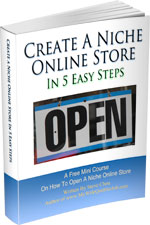
Ready To Get Serious About Starting An Online Business?
If you are really considering starting your own online business, then you have to check out my free mini course on How To Create A Niche Online Store In 5 Easy Steps.
In this 6 day mini course, I reveal the steps that my wife and I took to earn 100 thousand dollars in the span of just a year. Best of all, it's absolutely free!


